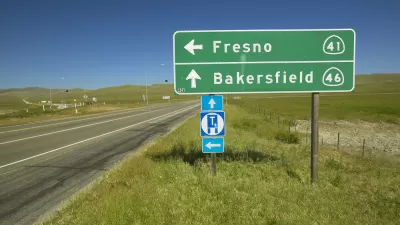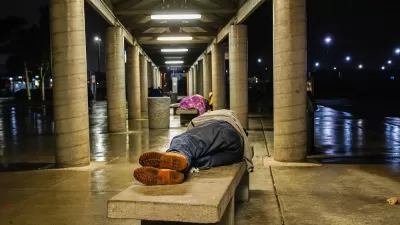Amanda Eaken details Kern County's new Regional Transportation Plan/Sustainable Communities Strategy (RTP/SCS). The new plan implements California's SB 375, which serves as the land use component of California's carbon emissions reductions goals.
"With the third most polluted air in the country in 2013, the 5th fastest growth rate of all California counties in 2012, and now a steady state-wide stream of funding to support sustainable communities from cap and trade proceeds, Kern County has much to gain from sustainable planning."
Eaken's coverage of the new plan breaks the plans into list of "good news" and "bad news" about what the plan achieves and where it falls short.
Among the positives, according to Eaken:
- The plan "contains seven times more funding both for transit (exclusive of high speed rail) and for bicycle/pedestrian infrastructure compared with their last long range transportation plan adopted in 2011."
- The plan anticipates future changes in housing demand: "the adopted plan’s land use scenario accommodates 21% of new development in infill areas as opposed to only 1% in the 2011 plan, and it places more emphasis on multi-family and small-lot single family homes in an effort to create more walkable communities."
And then some of the plan's shortcomings, according to Eaken:
- The plan did not adopt the Balanced Growth Scenario supported by the National Resources Defense Council and will pursue the Centennial Corridor highway plan, "slated to demolish over 200 homes in an historic neighborhood."
- The plan still targets greenfield development: "the RTP/SCS is projected to consume over 91 square miles of farmland, working landscapes and other open space, an area more than half the size of Bakersfield."
FULL STORY: 'Cause how many of you that sit and judge me, ever walked the streets of Bakersfield?

Planetizen Federal Action Tracker
A weekly monitor of how Trump’s orders and actions are impacting planners and planning in America.

Map: Where Senate Republicans Want to Sell Your Public Lands
For public land advocates, the Senate Republicans’ proposal to sell millions of acres of public land in the West is “the biggest fight of their careers.”

Restaurant Patios Were a Pandemic Win — Why Were They so Hard to Keep?
Social distancing requirements and changes in travel patterns prompted cities to pilot new uses for street and sidewalk space. Then it got complicated.

Maui's Vacation Rental Debate Turns Ugly
Verbal attacks, misinformation campaigns and fistfights plague a high-stakes debate to convert thousands of vacation rentals into long-term housing.

San Francisco Suspends Traffic Calming Amidst Record Deaths
Citing “a challenging fiscal landscape,” the city will cease the program on the heels of 42 traffic deaths, including 24 pedestrians.

California Homeless Arrests, Citations Spike After Ruling
An investigation reveals that anti-homeless actions increased up to 500% after Grants Pass v. Johnson — even in cities claiming no policy change.
Urban Design for Planners 1: Software Tools
This six-course series explores essential urban design concepts using open source software and equips planners with the tools they need to participate fully in the urban design process.
Planning for Universal Design
Learn the tools for implementing Universal Design in planning regulations.
Heyer Gruel & Associates PA
JM Goldson LLC
Custer County Colorado
City of Camden Redevelopment Agency
City of Astoria
Transportation Research & Education Center (TREC) at Portland State University
Camden Redevelopment Agency
City of Claremont
Municipality of Princeton (NJ)





























